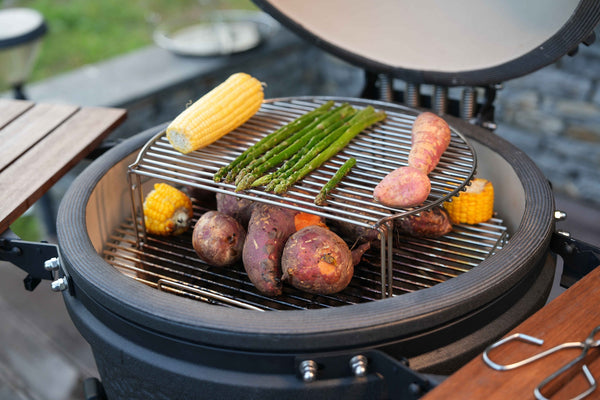
Cast Iron vs. Stainless Steel Grates: Pros & Cons for Your Grill
The Foundation of Your Grill
Every flavorful steak, charred vegetable, or beautifully marked fillet from your grill starts with a crucial component: the grill grates. As the direct point of contact between food and fire, grill grates shape your grilling experience more than you might think. The material you choose not only influences cooking results but also affects care, longevity, and even the style of your outdoor cooking sessions.
The two main contenders in the world of kamado grill grates are cast iron and stainless steel. Each offers distinct advantages and unique challenges, making the choice a heated debate among grill enthusiasts. In this guide, we’ll break down the characteristics, pros, cons, and ideal uses for each, helping you pick the best grates for your culinary goals.
Vessils understands that quality equipment makes every grill session better—that’s why our lineup of Grills and Accessories includes versatile options for every grate material and grilling style.

Understanding Cast Iron Grill Grates
-
Characteristics: Heavy and dense, cast iron is known for outstanding heat retention and even distribution once fully heated.
-
Heat Performance: These grates absorb and hold heat exceptionally well, ensuring a steady temperature across the surface and delivering those deep, restaurant-quality sear marks.
-
Seasoning: With repeated oiling and heating, cast iron develops a natural non-stick layer, creating a protective barrier against rust and boosting food release.
-
Ideal Use Cases: Perfect for high-heat applications—think searing steaks, chops, and foods that benefit from a flavorful crust. For signature results, see The Perfect Steak on a Kamado Grill.

Understanding Stainless Steel Grill Grates
-
Characteristics: Lighter in weight and highly resistant to rust, stainless steel is a popular alloy choice for modern grill grates.
-
Heat Performance: Stainless steel heats quickly but doesn’t hold or distribute heat quite as evenly or as long as cast iron. It’s particularly responsive, adjusting swiftly to temperature changes.
-
Durability & Maintenance: Naturally corrosion-resistant and less prone to rust, making it easier to clean and care for than cast iron.
-
Ideal Use Cases: Excellent for grilling delicate fish, veggies, and poultry, and situations where quick heat adjustments are needed.
Cast Iron Grates: Pros and Cons
Pros
-
Superior Heat Retention & Searing: Delivers unmatched sear marks and caramelization.
-
Even Heat Distribution: Reduces the risk of hot and cold spots across the cooking surface.
-
Durability: When properly cared for, cast iron grates can last for decades.
-
Natural Non-Stick: With consistent seasoning, these grates develop an easy-release surface that improves over time.
Cons
-
High Maintenance: Require regular cleaning and re-seasoning to protect against rust. See How to Deep Clean a Kamado Grill.
-
Rust-Prone: Susceptible to moisture if not well-seasoned.
-
Heavy: More cumbersome to lift, clean, and reposition than stainless steel.
-
Slower to Heat: Need more preheat time before cooking, but compensate with steady, sustained heat.
Stainless Steel Grates: Pros and Cons
Pros
-
Corrosion & Rust Resistance: Well-suited for outdoor environments and less prone to degradation.
-
Low Maintenance: Easier to clean and typically don’t require seasoning.
-
Lightweight: Simple to remove, handle, and clean.
-
Quick to Heat: Gets up to cooking temperature rapidly—great for fast-paced grilling.
-
Responsive to Temperature Changes: Adjusts easily to shifts in grill settings.
Cons
-
Less Heat Retention: May produce fainter sear marks and less crust compared to cast iron.
-
Potential for Sticking: Foods can stick if the grate isn’t well-oiled or preheated.
-
Can Discolor: Will develop a patina after extensive use, though this doesn’t impact performance.
-
Less Even Heat Spread: Can have more hot and cool spots due to rapid thermal response.
Which Grate Is Right for You?
Consider Your Cooking Style:
-
If you’re a searing enthusiast who loves crusty steaks and thick chops, cast iron may be your best choice.
-
For low-maintenance grillers focused on fish, veggies, or lighter proteins, stainless steel suits most needs.
-
Many kamado grills (like the Vessils Classic Full-Size 19" are compatible with both—giving you the ability to switch based on the cook.
Other Decision Factors:
-
Food Types: What you grill most frequently—delicate fillets benefit from stainless steel, thick cuts thrive on cast iron.
-
Maintenance Commitment: Are you willing to season and protect cast iron, or is “rust-free, quick clean” more your pace?
-
Versatility: Owning both types gives the most flexibility; consider swapping grates depending on the recipe.
-
Heat Control: Regardless of grate type, a good Electronic Thermometer is crucial for temperature precision. See How to Control Temperature in a Kamado Grill for top venting and control tips.
The Right Grate for Your Grill
Both cast iron and stainless steel grates bring distinct strengths to your grill game. By choosing the right material, you tailor your grilling experience—whether you want deep crust and classic marks or simple cleanup and all-around convenience.
Empower your cooking: Browse Vessils’ full selection of Grills and Accessories, including Best Kamado Grill Accessories, to upgrade your setup—and get ready to experience next-level results, no matter what’s on the menu.
